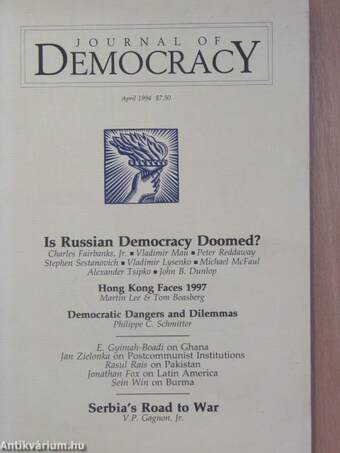1.069.408
kiadvánnyal nyújtjuk Magyarország legnagyobb antikvár könyv-kínálatát

VISSZA
A TETEJÉRE
JAVASLATOKÉszre-
vételek
Journal of Democracy April 1994
Volume 5, Number 2
| Kiadó: | Johns Hopkins University Press |
|---|---|
| Kiadás helye: | Baltimore-London |
| Kiadás éve: | |
| Kötés típusa: | Ragasztott papírkötés |
| Oldalszám: | 160 oldal |
| Sorozatcím: | Journal of Democracy |
| Kötetszám: | |
| Nyelv: | Angol |
| Méret: | 23 cm x 15 cm |
| ISBN: | |
| Megjegyzés: | További szerzők a kötetben. |
naponta értesítjük a beérkező friss
kiadványokról
naponta értesítjük a beérkező friss
kiadványokról
Előszó
en Russian president Boris Yeltsin's decision to dissolve the
Russian Supreme Soviet led to an uprising that was suppressed by
military units in October 1993, the implications for the future of... Tovább
Előszó
en Russian president Boris Yeltsin's decision to dissolve the
Russian Supreme Soviet led to an uprising that was suppressed by
military units in October 1993, the implications for the future of Russian
democracy were unclear. The resort to force on both sides of the
conflict had brought the country to the verge of civil war and had set
a most dangerous precedent. At the same time, the stalemate between
Yeltsin and the antireformist forces had seemingly been broken, thus
creating an opportunity to hold a referendum on a new Constitution and
to select a new parliament in fully democratic elections.
On 12 December 1993, Russians went to the polls to vote "yes" or
"no" on Yeltsin's proposed Constitution and to cast three separate ballots
for members of their new bicameral legislature, the Federal Assembly.
The first ballot permitted voters to select two candidates from their
region for the Council of the Federation, the 176-member upper house,
with the two candidates receiving the highest vote totals in each of the
88 regions being elected. The second and third ballots determined the
allocation of seats in the State Duma, the 450-member lower house. Half
of these seats were awarded to the candidates who received a plurality
of votes on the second ballot in each of 225 single-seat constituencies.
The remaining half were allocated by proportional representation (with
a 5-percent minimum threshold) among party lists according to the
percentage of the vote that each party received on the third ballot.
Although the new Constitution was approved by a narrow margin, the
parliamentary vote (see Table 1 on p. 6 below) was a great
disappointment for proponents of reform. In an effort to assess the
implications of these critical elections for the future of Russian
democracy, we asked a number of leading Western analysts and three
prominent Russians representing a variety of viewpoints (pro-Gaidar,
anti-Gaidar reformist, and "centrist") to write brief essays addressing the
following questions: 1) What are the principal factors that accounted for
the outcome of the December 1993 parliamentary elections? 2) Did these
election results constitute a significant setback for the process of
democratic transformation and consolidation in Russia? 3) How great is
the threat that in the near future, totalitarian forces of either the Right
or the Left might come to power in Russia, or that the country might
fall apart? We believe that our readers will find the range of responses
fascinating, although we fear that they will also be dismayed by the
generally bleak picture that our authors paint.
—The Editors, 10 March 1994 Vissza
Tartalom
-p-^ JOURNAL OF^j-
Democracy
April J 994 Volume 5, Number 2
Is Russian Democracy Doomed? 3
Michael McFaul, Vladimir M. Lysenko, Peter Reddaway,
Alexander Tsipko, Stephen Sestanovich, John B. Dunlop,
Vladimir Mau, Charles H. Fairbanks, Jr.
Broken Promises: Hong Kong Faces 1997
Martin CM. Lee & Tom Boasberg 42
Dangers and Dilemmas of Democracy
Philippe C. Schmitter 57
Ghana's Uncertain Political Opening
E. Gyimah-Boadi 75
New Institutions in the Old East Bloc
Jan Zielonka 87
Latin America's Emerging Local Politics
Jonathan Fox 105
Serbia's Road to War
V.P. Gagnon, Jr. 117
Pakistan: Hope Amidst Turmoil
Rasul Bakhsh Rais 132
Field Reports
Sustaining Burma's Hopes for Freedom
Sein Win
Témakörök
- Történelem > Társadalomelmélet
- Idegennyelv > Idegennyelvű könyvek > Angol > Folyóiratok, újságok
- Idegennyelv > Idegennyelvű könyvek > Angol > Történelem > Egyéb
- Folyóiratok, újságok > Tudományos
- Folyóiratok, újságok > Történelem
- Történelem > Folyóiratok, közlemények, évkönyvek > Külföldi
- Történelem > Idegennyelvű > Angol
- Történelem > Politika > Politikai rendszerek
- Történelem > Politika > Politológia
Megvásárolható példányok
Nincs megvásárolható példány
A könyv összes megrendelhető példánya elfogyott. Ha kívánja, előjegyezheti a könyvet, és amint a könyv egy újabb példánya elérhető lesz, értesítjük.



